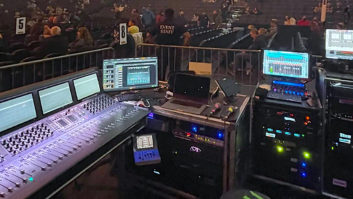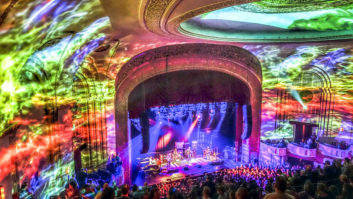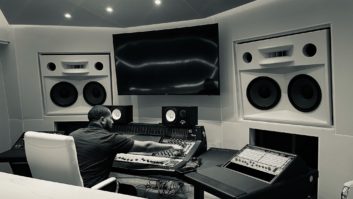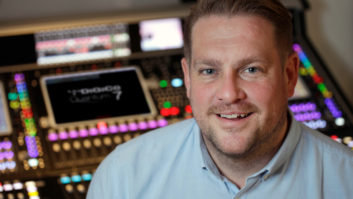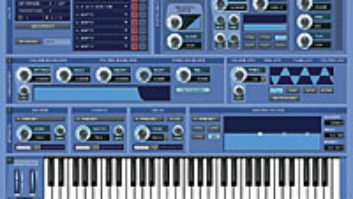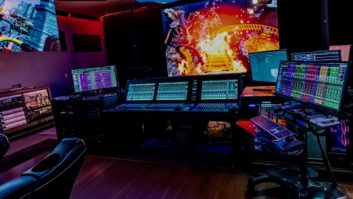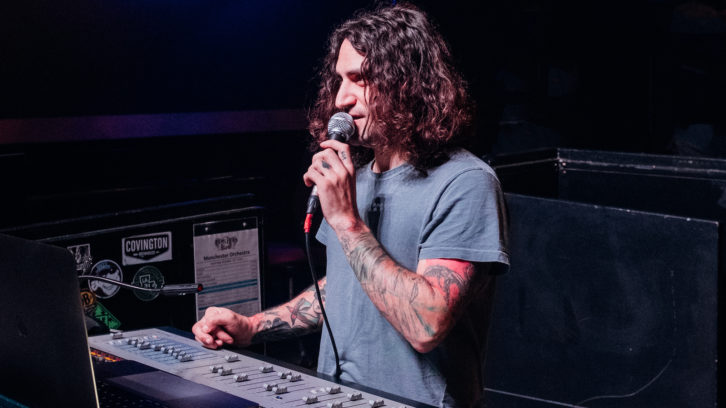
New York, NY (November 24, 2021)—After a near four-year wait, Atlanta-based alt rockers Manchester Orchestra unveiled their latest album earlier this year and immediately began planning to hit the road. The new collection, The Million Masks of God, found the band delivering cinematic moments that were just begging to be made even more expansive in a live setting, and the group’s recent fall tour finally provided an opportunity to do just that.
Starting in Dallas and rolling up the east coast over three weeks in October, the 12-date run culminated with a sold-out night at New York City’s 2,200-cap Hammerstein Ballroom. Along the way, the band used local control gear and PAs at each stop, much as it had in the past, so FOH engineer TJ Elias and monitor man Mike Rogers spent much of each day focused on creating uniform experiences for the group and its audiences, night after night.
Ensuring aural consistency—particularly during more epic moments onstage—often required extensive preparation beforehand, whether learning the room, finding the appropriate effects to match it, or something else. For Elias, that approach drew on his main career as a studio engineer; while he may co-own Atlanta’s Big Trouble Recording with business partner Dan Gleason of Grouplove, Elias started out as the studio assistant of mega-engineer Nick DiDia for nearly five years, working with producers like Brendan O’Brien and Ben H. Allen in the process. When stepping into a live setting then, he brings his recording-world analytical skills to the table.
“The main thing for me,” he said, “is going in, tuning a room and spending a lot more time when I get into the venue listening to music and listening to the guys play in there, and then really fine- tuning the balance of how the room is sounding and what the room needs to do…. I had a lighting guy from one of the places go, ‘I didn’t know front of house engineers do this much work!’”
Elias wasn’t reinventing the wheel nightly, but instead figuring out the best game plan for what he wanted to achieve. “When you’re making or a mixing an album, you’re finding elements that will pull you into the songs, and there’s a similar vibe in the way Manchester plays shows and orchestrates the setlist,” said Elias. “A lot of it for me is finding these different spaces where yes, we may be in this one particular venue, but it’s like, ‘How do I transfer you to another room where this song actually takes place?’”
With gear, venues and vibes changing nightly, some parts of the setlist became a perpetual work-in-progress: “I use the record as a guideline, but they’re not playing the songs exactly like the records all the time; they have new arrangements that are meant to have a different energy and vibe, so to me, it’s ‘do a tip of the hat,’ see where things sit blend-wise, find new soundscapes, use different effects with the vocal, and things like that. We figure out how that plays night after night with different venues.”
Much of Elias’ approach to the band’s live mix centered around implementing different effects to fit the room appropriately, despite using different gear nightly. “That’s been my gripe in the past with a lot of live sound consoles and what’s on them,” he said. “It’s very difficult sometimes to get the big lush reverb sounds that I want for the show. I was like, ‘I know I can do this with these things in the studio; let me figure out how to make that work’— and now we’ve got that working.”
Whatever It Takes, Part 1: The DMB Overcome COVID Crises
Whatever It Takes, Part 2: Mixing the DMB Live
Key to his effort was a computer packed with Universal Audio UAD plug-ins, used most notably for time-based effects on singer Andy Hull’s vocals: Since they’re all time-based effects, I don’t have to worry as much about delay between the console and processing into my computer. I do a lot on my Echoplex, there’s a few small plate reverbs, little room sounds, things I use for drums, but I use my EMT 250 reverb all night in different capacities. I’m always in and out of that and have it up at all times on my computer so I can change how long the reverb time is. I send a single, repeated delay into it so I can time-out delay throws in a way so that it’s always in time. On some songs, some parts of the verse, I may have it really fast and tight, and then other times on that same verse, I’ll need to slow it down, so I’ll be tapping it at a 16th note and slow down to a quarter note by the end of the verse to get the length on it. It’s constant movement and that’s a big part of it. Of course, their damn good singing makes my life a lot easier! I can do almost anything with it.”
Up on stage, further efforts were made to provide consistency for the group, from the tour carrying a monitor desk for Rogers, to drummer Tim Very adopting in-ear monitors for the first time, to Hull hearing himself nightly on his own pair of L-Acoustics wedges. “They have been great for Andy and really great for Mike, too,” said Elias. “Now it’s smooth up there unless the room sounds crazy, but Mike’s always got it dialed in. There’s rooms we’ve been in that I’m like ‘I don’t know how Mike’s gonna do this,’ and the guys get offstage like, ‘The stage sounded incredible,’ so he’s a wizard.”
Aiding in the wizardry is a mic pack curated by both engineers. “Andy, I’ve always just had a 58 on his vocal,” said Elias. “We’ve experimented, but ultimately there’s something about him on a 58 live and an SM7 in the studio; his voice just works for those microphones. I’ve gone through different things with his vocal—back-end stuff, front-end stuff, different mics—and it always ends up that the 58 is the one. It works like a charm and there’s a reason that you’ve seen them for so many years on so many different applications.”
Milwaukee’s Summerfest: The “Big Gig” Is Back
While lead guitarist Robert McDowell was nabbed with Shure Beta58s on his side of the stage, capturing Hull’s acoustic guitar work, on the other hand, came down to both his custom Taylor guitars and the tools on-hand. “I want to say 85% of the DIs on stage are Rupert Neve Designs RNDIs,” said Elias. “We run his guitar through it, and that DI coupled with everything going on inside of that guitar just works magic.”
All that gave Elias plenty to work with, he said; the main thing was to capture and present it all accurately. “These guys have already put all the colors in the palette, and I need to put those colors together into the full picture without adding to it, in a sense. To me, that’s a big thing, even in recording; it’s making the effort on the front end. If you don’t like how something sounds, you don’t grab an EQ; you move the microphone.”
Of course, the house console and PA of the day were equally crucial for achieving those goals, and like all engineers, Elias has his favorites: “Any night I have an L-Acoustics rig in the room, I am the happiest person on Earth because I feel like I’m mixing at the studio. The clarity is there, the punch is there. I never feel like anything’s too overbearing in those rigs; you can really hear when something needs to be moved or EQ’ed. L-Acoustics with a DiGiCo desk? You’ll never hear me complain, because I want the cleanest processing humanly possible, and for me, that’s happened every night we have a DiGiCo console.”
Bringing Avatar’s Death Metal to Life on Tour
Rewarding experiences for the audio team and the group ultimately led to achieving the tour’s true goal—creating rewarding experiences for the fans. The band and engineers will get to do it all again in January, hitting the road for three months through Europe and more of the U.S.
Elias observed, “We’re getting a lot more of a respectful crowd that realizes there’s points to cheer and have a good time, and there’s points to sit down and focus and watch what’s happening on stage. A lot of that has to do with how well the band is manning the stage; they get that crowd ready to come along for the ride. It’s different—a lot more honed in and everyone’s firing on a higher level than we ever have before, so it’s pretty awesome.”
